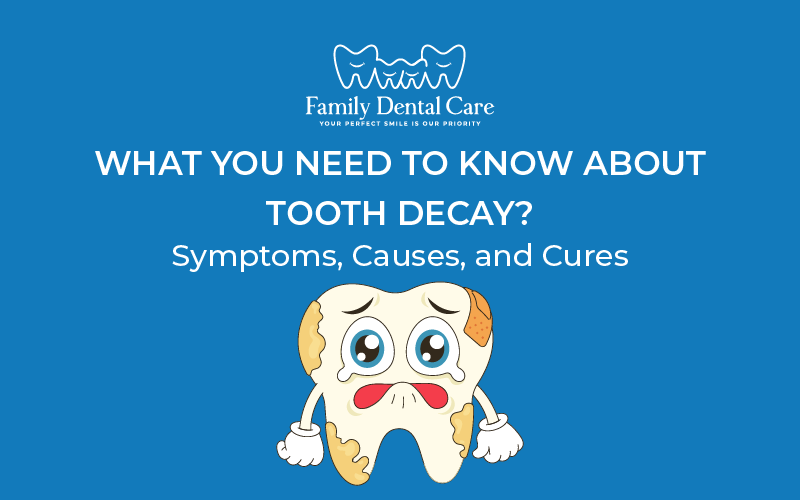Tooth decay initiates the erosion of enamel, the tough outer layer of a tooth. As it progresses, decay penetrates deeper layers, forming cavities. Treatment options encompass fluoride, fillings, crowns, and more. Tooth decay may lead to oral and dental issues if left untreated.
However, several treatments provide barriers to its progression, either by prevention or inhibition. To understand tooth decay and how to manage it, it’s crucial to grasp its symptoms, causes, and available treatments. Here’s a simplified guide to help you navigate this common dental issue:
What is Tooth Decay?

Tooth decay also referred to as dental caries or cavities, results in the deterioration of tooth enamel. This condition may lead to sensitivity to sugary, hot, or cold foods and beverages. The tooth comprises three layers-
1. Enamel
It forms the tough outer shell safeguarding the inner tooth layers. Enamel lacks living cells and stands as the body’s hardest structure.
2. Dentin
Positioned beneath the enamel, dentin becomes exposed when the enamel is compromised. Dentin contains small tubules that transmit sensations of temperature to the tooth nerves, causing discomfort or sensitivity.
3. Pulp
Situated at the core of the tooth, the pulp houses blood vessels, nerves, and connective tissue. Tooth decay’s impact varies, ranging from enamel erosion to severe abscesses affecting the tooth’s pulp and causing considerable pain.
Symptoms of Tooth Decay
It is important to note that symptoms of tooth decay can vary depending on the severity of the damage caused, ranging from mild sensitivity to severe toothache or visible holes in the teeth.
Additionally, individuals may experience pain or discomfort while chewing, sensitivity to hot, cold, or sweet foods and drinks, and visible discoloration or staining on the tooth surface. Regular dental check-ups are essential to detect and address tooth decay early, preventing further complications.
– Visible Discoloration: Look out for any brown, black, or white spots on your teeth, which could indicate decay.
– Tooth Sensitivity: A tooth sensitive to cold or hot foods and drinks can be a sign of decay.
– Pain: Persistent toothache is a classic symptom, especially when chewing.
– Bad Breath: Ongoing bad breath or a bad taste in your mouth can also be a symptom.
Read Also: Why Choose Family Dental Simi Valley For Your Dental Needs?
Causes of Tooth Decay

1. Sugary and Acidic Foods- Consuming foods and drinks high in sugar and acids can erode tooth enamel.
2. Poor Oral Hygiene- If you don’t brush or floss on a regular basis, plaque can accumulate and erode the tooth enamel.
3. Dry Mouth- Saliva helps to wash away food and neutralize acids, so a lack of it can contribute to decay.
4. Bacteria and Plaque- These naturally occurring elements in your mouth can lead to decay if not properly managed.
Preventive Measures
– Regular Brushing and Flossing: This basic routine removes plaque and food particles.
– Healthy Diet: Limiting sugar intake and acidic foods helps preserve tooth enamel.
– Regular Dental Check-ups: Professional cleanings and exams can catch problems early.
Treatment Options

1. Tooth Cavity Treatment
This process begins with the dentist removing the decayed part of the tooth, a procedure often referred to as drilling. The next step involves thoroughly cleaning the affected area to ensure all decay has been eliminated.
After the decay is removed, the dentist fills the cavity with a filling material such as amalgam, composite resin, or another suitable substance. This not only restores the tooth’s structure but also prevents further decay by sealing off any cracks or crevices where bacteria might enter.
2. Sensitive Teeth Treatment
Sensitivity in teeth, often triggered by hot or cold temperatures, can be managed using specialized toothpaste designed for sensitive teeth, such as whitening treatment for sensitive teeth. These toothpastes contain ingredients that help block the pathways through the teeth that attach to nerves, reducing sensitivity.
Additionally, dentists can apply fluoride varnishes or plastic resins to the sensitive areas of your teeth to strengthen enamel and reduce discomfort. Maintaining good oral hygiene and using a soft-bristled toothbrush can also help minimize tooth sensitivity over time.
3. Dental Cavity Treatment
When dental decay is more extensive, treatments such as inlays, onlays, or crowns may be necessary. Inlays and onlays are used when the decay is too large for a simple filling but not severe enough to require a crown.
The dentist bonds them to the tooth after having them produced to order at a dental laboratory. Crowns, on the other hand, are used when a significant portion of the tooth is decayed or damaged. They cover the entire visible part of the tooth, providing strength and protecting it from further decay.
4. Root Canal Treatment
This treatment is required when decay reaches the pulp of the tooth, which contains nerves and blood vessels. A root canal involves removing the infected pulp, cleaning and disinfecting the inside of the tooth, and then filling and sealing it.
This procedure not only saves the tooth from extraction but also prevents the infection from spreading to other areas of the mouth. After a root canal, the tooth is usually restored with a crown or filling to ensure its functionality and appearance.
5. Tooth Extraction
In cases where the tooth is severely damaged or decayed beyond repair, extraction may be the only viable option. The tooth must be taken out of its bone socket during this procedure.
Tooth extraction treatment can prevent the spread of infection to other parts of the mouth and alleviate pain. After an extraction, it’s important to discuss tooth replacement options with your dentist to avoid shifting the remaining teeth and to maintain the ability to chew and speak properly.
6. Advanced Family Dental Care
Regular dental check-ups and cleanings are crucial for maintaining oral health and preventing decay. During these visits, dentists can detect early signs of tooth decay, gum disease, and other dental issues, often before they become serious.
Plaque and tartar that are difficult to remove with brushing and flossing alone are removed by professional cleanings. These visits also provide an opportunity for individuals to learn about proper oral hygiene practices and receive advice tailored to their specific needs, ensuring the whole family maintains optimal dental health.
Advanced Treatments
For more severe cases, advanced treatments might be needed-
– Crown: If a large portion of the tooth is decayed, a crown might be necessary after the decay is removed.
– Root Canal Treatment: This is needed if the decay has reached the tooth’s nerve. The nerve and decayed tooth material are removed, and the space is filled.
Conclusion
Managing tooth decay involves a combination of good oral hygiene practices, regular dental visits, and being proactive about treatment when issues arise. For those in the Simi Valley area seeking comprehensive care, consulting a dentist in Simi Valley can provide personalized treatment plans, including anything from sophisticated root canal procedures to cavity fillings, you can be sure that your oral health is in capable hands.
Remember, early detection and prompt tooth decay treatment are key to preventing more serious problems, so don’t hesitate to reach out to your dental care provider if you’re experiencing any symptoms of tooth decay.

